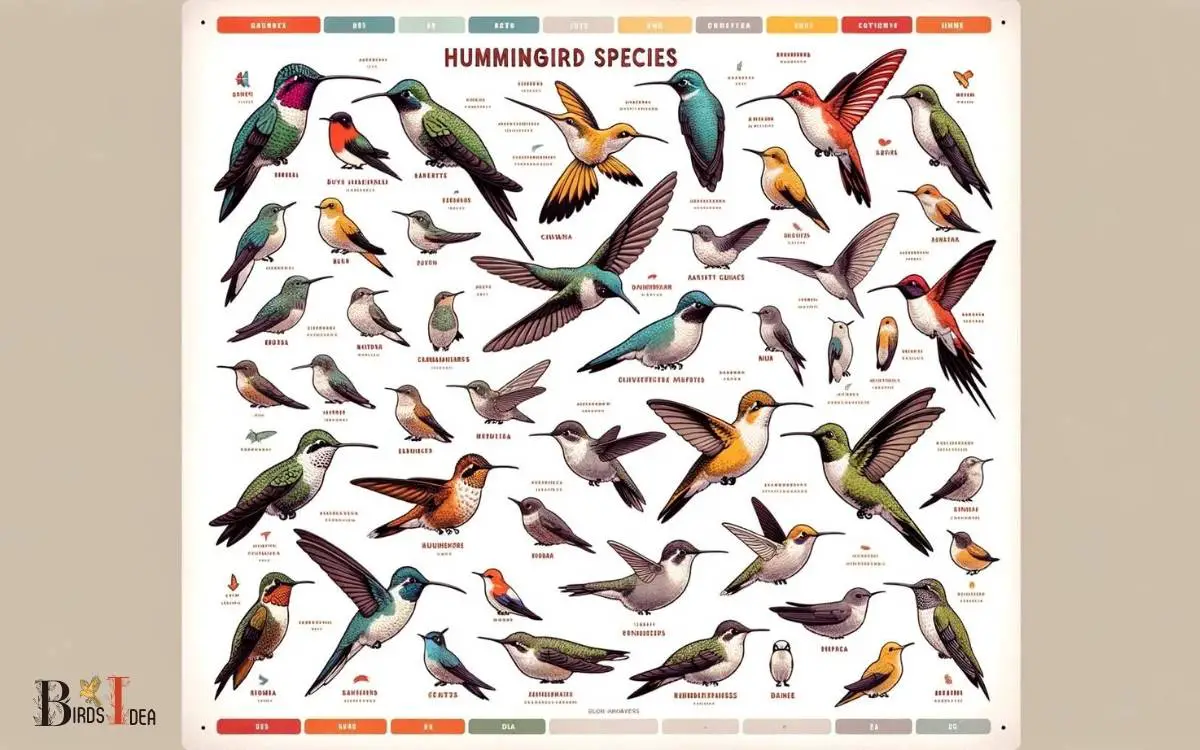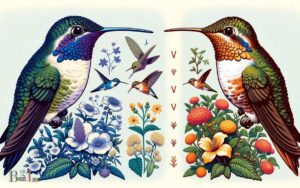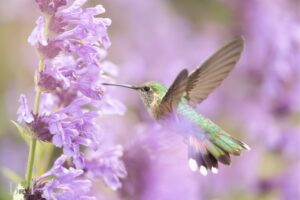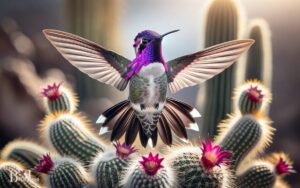How Many Types of Hummingbirds Are There? 330 Species!
There are over 330 recognized species of hummingbirds, making them the second-largest bird family in the Americas.
Hummingbirds are part of the family Trochilidae and are known for their rapid wing-flapping, which allows them to hover in place a unique trait among birds.
These tiny, brightly colored birds primarily feed on nectar, which gives them the energy necessary for their high metabolism and swift flight.
Hummingbirds are native to the Americas, with the greatest species diversity found in South and Central America, particularly in tropical and subtropical regions.
Here are some interesting details about hummingbirds:
With a dazzling array of over 330 species, hummingbirds add vibrant dynamism to the ecosystems of the Americas through their roles as pollinators and consumers of insects.

Key Takeaway
The Diversity of Hummingbird Species
While there are approximately 360 known species of hummingbirds, their diversity is characterized by variations in size, coloration, and habitat preferences.
These remarkable birds range in size from the tiny bee hummingbird, which measures a mere 2 inches in length, to the giant hummingbird, which can reach up to 8 inches.
Their vibrant plumage displays a wide array of colors, with some species exhibiting iridescent feathers that shimmer and change in the light.
Additionally, hummingbirds have adapted to a range of habitats, from lush tropical forests to arid desert regions, showcasing their ability to thrive in diverse environments.
This diversity in size, coloration, and habitat preferences reflects the remarkable adaptability and evolutionary success of the hummingbird species.
Distribution and Habitat of Hummingbirds
Hummingbirds inhabit a wide range of ecosystems, from tropical rainforests to high-altitude meadows. Their geographic distribution spans from Alaska to Tierra del Fuego, with the majority of species found in Central and South America.
These tiny birds have evolved a variety of adaptations to thrive in diverse environments, including specialized beaks for accessing nectar and the ability to enter a state of torpor to conserve energy during periods of food scarcity.
Hummingbirds’ Diverse Habitats
Inhabiting diverse ecosystems throughout the Americas, hummingbirds display a wide range of habitat preferences.
These tiny birds can be found in various habitats, including:
- Tropical rainforests
- High-altitude mountain ranges
- Coastal areas
Hummingbirds have adapted to thrive in these diverse environments, utilizing their unique flying abilities and specialized beaks to access nectar from flowers and catch insects for protein.
The availability of suitable nesting sites and food sources influences their distribution, leading to a fascinating array of hummingbird species across the Western Hemisphere.
Understanding the specific habitat requirements of different hummingbird species is crucial for their conservation and underscores the importance of preserving the rich biodiversity of the Americas.
Geographic Distribution of Hummingbirds
Thriving in diverse ecosystems throughout the Americas, they demonstrate a remarkable range of habitat preferences.
From the high Andes to lowland rainforests, hummingbirds are found in a variety of environments, showcasing their adaptability.
Below is a table illustrating the geographic distribution of hummingbirds in different regions of the Americas.
| Region | Habitat |
|---|---|
| North America | Forests, meadows, gardens, and coastal areas |
| Central America | Rainforests, cloud forests, and mountainous regions |
| South America | Andes mountains, savannas, and coastal areas |
| Caribbean | Islands, coastal areas, and tropical forests |
This table highlights the diverse range of habitats where hummingbirds can be found, showcasing their ability to thrive in various ecological niches throughout the Americas.
Adaptations to Various Environments
Demonstrating remarkable adaptability, hummingbirds have evolved specific physiological and behavioral traits to thrive in diverse habitats across the Americas.
Their remarkable adaptations include:
- High metabolic rates, enabling them to sustain their incredible hovering flight and rapid wingbeats, essential for feeding on nectar from flowers.
- Specialized beaks that vary in size and shape to suit different flower types, allowing them to access nectar from a wide range of floral species in their respective habitats.
- Unique migration patterns, with some species traveling thousands of miles to find suitable breeding grounds and food sources, showcasing their ability to navigate and survive in varying environments.
These adaptations not only reflect the incredible diversity of hummingbird species but also inspire awe at their ability to thrive in a multitude of ecological niches.
Unique Physical Characteristics of Hummingbirds
Hummingbirds are known for their vibrant feather colors, which are often iridescent and can appear to change in different lighting.
Additionally, their rapid wing movement allows them to hover in place and maneuver with incredible agility.
These unique physical characteristics contribute to the remarkable abilities of hummingbirds in foraging for nectar and evading predators.
Vibrant Feather Colors
The diverse array of vibrant feather colors exhibited by different types of hummingbirds serves as a striking testament to the unique physical characteristics of these avian species.
Hummingbirds’ feathers display an astonishing variety of hues, including iridescent greens, fiery reds, shimmering blues, and vibrant purples.
These colors are not merely for aesthetic appeal but serve vital purposes, such as attracting mates, camouflaging from predators, and signaling territorial boundaries.
The intricate patterns and striking contrasts on their feathers also play a role in species recognition and individual identification, highlighting the importance of these vibrant colors in the social dynamics of hummingbird populations.
As we delve into the mesmerizing world of hummingbird feather colors, it becomes evident that these hues are not just a visual spectacle but an integral part of their survival and reproductive strategies.
Rapid Wing Movement
Characterized by rapid wing movement, hummingbirds possess a unique physical attribute that enables them to achieve remarkable aerial feats.
Their wings beat at an astonishing rate of 50 to 80 times per second during normal flight and can reach up to 200 times per second during courtship displays or high-speed maneuvers.
This rapid wing movement allows hummingbirds to hover in mid-air, fly backward, and change direction quickly with incredible agility. Their wings are also capable of rotating in a full circle, further enhancing their aerial abilities.
This exceptional adaptation is due to the hummingbird’s highly specialized musculature and unique shoulder joint, which enable such rapid and precise movements.
The extraordinary wing speed of hummingbirds is a key factor in their ability to thrive in diverse ecosystems and outmaneuver other bird species in search of nectar and insects.
Feeding Behaviors and Diet of Hummingbirds
There are several different types of feeding behaviors and diets exhibited by various species of hummingbirds. These tiny birds have evolved unique strategies to meet their high energy demands.
- Nectarivorous species rely primarily on the nectar of flowers, using their long, specialized bills and tongues to extract the sugary liquid.
- Insectivorous species consume a large number of insects and spiders to fulfill their protein and fat requirements, often catching them in mid-air or plucking them from leaves and bark.
- Some species supplement their diets with tree sap, pollen, and fruit, showcasing their adaptability and flexibility in finding sources of sustenance.
Understanding these diverse feeding behaviors and diets is crucial for conservation efforts and maintaining the delicate balance of ecosystems where hummingbirds play a vital role.
Breeding and Reproduction of Hummingbirds
Breeding and reproduction in hummingbirds are governed by intricate mating rituals and specialized nesting behaviors.
Male hummingbirds perform elaborate courtship displays to attract females, including aerial acrobatics and vocalizations.
Once a female selects a mate, she constructs a small, cup-shaped nest using plant fibers, moss, and spider silk, often camouflaging it with lichens and moss.
The female lays two tiny eggs, about the size of a coffee bean, and incubates them for 14-23 days. Hummingbird chicks are altricial, hatching blind and featherless.
The female feeds them a diet of regurgitated nectar and insects until they fledge, usually within 18-30 days. Hummingbirds typically raise one or two broods per breeding season, which varies by species and geographic location.
This complex reproductive process ensures the continuation of these remarkable avian species.
Conservation and Threats to Hummingbird Populations
The conservation and preservation of hummingbird populations are of paramount importance, especially considering the various threats they face in their natural habitats.
- Loss of habitat due to deforestation and urbanization
- Climate change affecting their migratory patterns and food sources
- Pesticide use leading to a decline in insect populations, a primary food source for hummingbirds
These threats are causing a decline in hummingbird populations worldwide.
Conservation efforts must focus on preserving their natural habitats, implementing sustainable land use practices, and raising awareness about the importance of protecting these unique and irreplaceable creatures.
It is crucial to take action to ensure the continued existence of these remarkable birds for future generations to admire and cherish.
Conclusion
The diversity of hummingbird species is vast, with over 300 different types found across the Americas. These remarkable birds have unique physical characteristics and specialized feeding behaviors, making them a fascinating subject of study.
However, conservation efforts are crucial to protect their habitats and address threats to their populations.
As the saying goes, “a drop in the bucket” when it comes to conservation efforts, every small action can make a big difference in preserving these extraordinary creatures.






